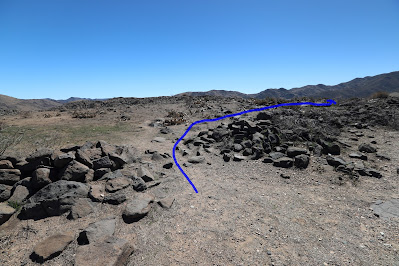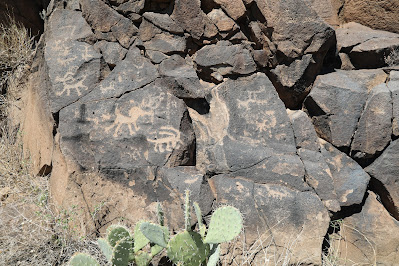
Round Trip Distance: 0.5 miles
Difficulty: Easy
Elevation: 3954 - 4000 feet
Cellphone: 0-3 bars
Time: 1 hr. 30 mins.
Trailhead: Squaw Creek Group
Fee: none
Attractions: petroglyphs
The Squaw Creek South Petroglyphs are located in the Tonto National Forest, bordering on the Agua Fria National Monument, northeast of Black Canyon City, Arizona. Scores of petroglyphs are found all along the base of the cliffs below the rim of the mesa. The North Petroglyphs are those that are directly below the Main Pueblo. Another large group of petroglyphs, those covered in this post, are along the same cliffs to the south of the pueblo.
After finding your way to the main pueblo enter the enclosure and follow the inside of the wall around to the rim on the right side of the pueblo where you will find a place to drop below the rim of the mesa.
An obvious trail leads over the side of the rim where it splits, with one branch heading north below the pueblo, and the other branch heading south along the base of the cliffs in that direction.
Immediately off to the right as soon as you turn south there are some petroglyphs high up on the cliff. It looks like some sheep and maybe a stalk of corn. Not sure what a bean plant would look like although this could be something entirely different from either.
Sheep are depicted in all manner of poses on many of the rocks as though each one has its own message to add to the general story line that was intended by their ancient artist.
The dotted circle with a line might represent a water tank fed by a spring. There are several of these tanks in the canyon below.
Two more large panels of deer and sheep.
This image looks like it was painted red at one time.
Maybe a man and a turtle and a man and a dragonfly?
There's this large boulder that can easily be missed if you take too high a route. A crossed circle represents the 'four elements'. I'm unaware of any special significance of two of them placed side by side.
A man, a turtle, and more sheep.
We turned around a little past this point just before reaching a turn in the canyon wall. We were still finding petroglyphs but no large panels of them.
In places like this you wonder if the petroglyphs might not go on as long as there was a cliff upon which to create them. The images seemed to be thinning out so we turned around where we did knowing that the best might be yet to come. If you would like to see them for yourself then all you have to do is 'Take a hike'.














